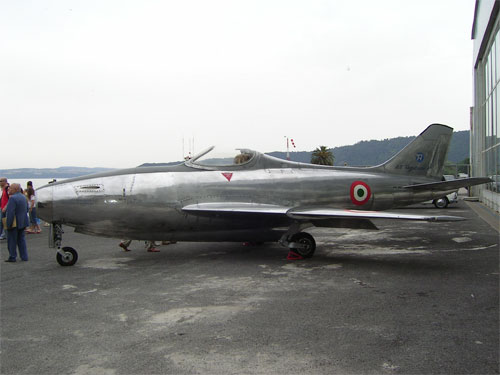
 |
|
#51
|
||||
|
||||
|
Quote:
|
|
#52
|
||||
|
||||
|
Re.2007 never existed as far as i know. A few older books do mention it as a fact but it was proven as a post-war forgery. There are no photos of that allegedly completely finished airframe save for the engines, nor any other trace of material evidence it ever existed - only some blueprints that were drawn in 1960's...
 VERO o FALSO? true or false? I now I'll prove it.  The Reggiane Re.2007 is a rather mysterious subject, and after more than 65 years, little has survived to this day, we know that was a design for a jet fighter began in the final days of the Italian Regia (1942), provided an engine of German origin, namely the Junkers Jumo 004B ... the same as the Me.262 (which only had two). With slightly swept wings, the real contribution of the longitudinal arrangement seems Re.2007 air intake, the cab and the engine in the same axis, by passing the flow of air around the cabin which was a good solution aerodynamic heritage undoubtedly the Campini Caproni, which is now quite obvious, the plans for the German fighters of that time, although in many ways more advanced, do not use this formula (presempio, often mounted on the cabin air intake) The prototype almost ready, do not get to mount the Junkers Jumo 004B in the final days of World War II, and no one knows the ultimate fate of this prototype, perhaps destroyed and lost his material ..... o. ... Maybe ................................. the project and mysteriously reappeared here:http://www.cmpr.it/Aerfer%20Sagittario%202/Aerfer.htm  Aerfer the Sagittarius-2 has nothing similar with Reggiane Re.2007, it's much less seen from outside and inside. In fact if you compare two sections of their planes can see the radical differences in design, clean Re.2007 a lineal arrangement of air intakes behind the cab and the engine Junkers Jumo 008B in the fuselage, L 'Aerfer Sagittarius-2 in return, with a curious arrangement "Diagonal" Rolls Royce Derwent engine-9, with the exhaust heat under the floor of the cabin (the pedals of the pilot dangerously close "cm" of the burners of the Derwent-9). The temporal distance of the two projects and more than a decade, it is clear that the origins of Aerfer are completely different, if anything, the only similarity is that all the two aircraft segment of the same nationality.  
|
|
#53
|
||||
|
||||
|
FIAT G55
Realizing that one of the main problems was the lack of the Royal hunting power of their radial engines, the Fiat G.50 Fiat gave the redesign, we think in various engines including the promising Fiat A.38, the Cuale was proposed for what would be the future G.55; 's A.38 was an engine with pistons in the V and about 1250 Hp. to increase the effectiveness he proposed a solution to counter the double helix (about 1940-41 ) later with the arrival of this engine DB.605 Made in Italy was left aside. 
Last edited by Xilon_x; 03-07-2011 at 01:06 PM. |
|
#54
|
||||
|
||||
|
|
|
#55
|
|||
|
|||
|
I would like to see the Italian fighters handle a bit better. I mean didn't they call the MC205 the Italian Spitfire. Just a thought.
|
|
#56
|
||||
|
||||
|
The Re.2007 looks like a F-86 Sabre.
__________________
 If you are insecure: use more bullets. |
|
#57
|
|||
|
|||
|
the G.55 cockpit photos in colour are actually of the rebuild made starting from a G.59 fuselage, so they might not be 100%, esp. the zinc chromate yellow used for the interior.
|
|
#58
|
|||
|
|||
|
Quote:
SpitV: wing loading 131,5 kg/m^2 power loading 0,40 hp/kg power loading with boost 0,50 hp/kg M.C.202: wing loading 174,2 kg/m^2 power loading 0,40 hp/kg (got the data from hardball's aircraft viewer, hope its right) it doesn't seem so unreasonable that the spit behaves better in both sustained and istantaneous turn. In this game even the 109 F2 and F4 turn better than the Folgore. 109F2 wing loading 172,9 kg/m^2 power loading 0,43 hp/kg And add the slats to that. Again the question it's not that simple but i gives an idea. For comparison: P40E wing loading 177,7 kg/m^2 power loading 0,30 hp/kg Which seems worse than the bf. but you can read noumerous accounts of p40 pilots outturning 109s in north africa. makes you wonder if the italian planes handled really that good or it was a matter of pilot. |
|
#59
|
||||
|
||||
|
Here's a beautiful post-war aircraft, Fiat G.59:
 One of those what-ifs that actually came true, namely, what if the Fiat G.55 had a Merlin engine. Less beautiful than the G.55 though, IMO. |
|
#60
|
|||
|
|||
|
yep, I talked to pilots back in Italy who flew both the G.59 and G.55 (and Mustang too): all of them confirmed that the G.55 was sleeker, but the G.59 was more docile, and above all never seemed to stall! The wings were so well aerodynamically balanced and designed that the plane would actually enter a slow glide and never drop a wing or make nasty surprises.
|
 |
| Thread Tools | |
| Display Modes | |
|
|